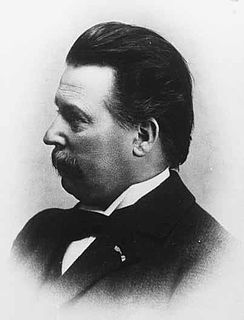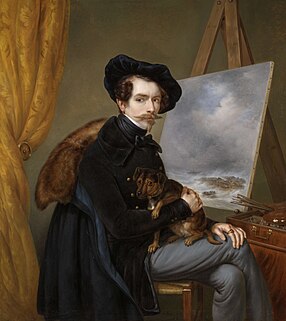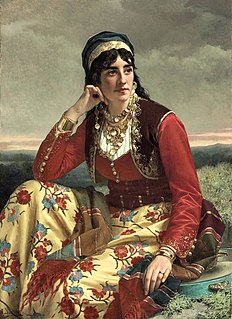
Johan Barthold Jongkind was a Dutch painter and printmaker. He painted marine landscapes in a free manner and is regarded as a forerunner of Impressionism.

Jacob Hendricus Maris was a Dutch painter, who with his brothers Willem and Matthijs belonged to what has come to be known as the Hague School of painters. He was considered to be the most important and influential Dutch landscape painter of the last quarter of the nineteenth century. His first teacher was painter J.A.B. Stroebel who taught him the art of painting from 1849 to 1852. Jacob Maris's most known works are the series of portraits of the royal House of Orange, he worked on these with his brother Matthijs Maris. He is also known for his portraits of landscapes like "Schip on the Scheveningen beach".

Dutch art describes the history of visual arts in the Netherlands, after the United Provinces separated from Flanders. Earlier painting in the area is covered in Early Netherlandish painting and Dutch and Flemish Renaissance painting.

Théophile Emile Achille de Bock was a Dutch painter belonging to the Hague School. Although many denigrate De Bock's work as too gray and too sketchy, Hague School champions love his work. Even Van Gogh was convinced of De Bocks "artistic temperament", although he eventually found his choice of subject too limited and tried to get De Bock to paint figure studies. But De Bock stuck to the subject he was good at, the Dutch landscapes.

Willem Witsen was a Dutch painter and photographer associated with the Amsterdam Impressionism movement.

Nasreddine Dinet was a French orientalist painter and was one of the founders of the Société des Peintres Orientalistes [Society for French Orientalist Painters]. He became so enchanted with North Africa and its culture, that he converted to Islam, and was proficient in Arabic. In addition to his paintings, he translated Arabic literature into French.

Jacob Campo Weyerman was a painter and writer during the period known as the Dutch Enlightenment. His work encompassed flower and fruit still life paintings, satirical magazines, plays, and biographies of painters. He usually signed his paintings with Campovivo.

Marius Alexander Jacques Bauer was a Dutch painter, etcher and lithographer, best known for his Oriental scenes. His style was largely Impressionistic, although it also derived to some extent from the Hague School. Many of his works were based on photographs he bought during his travels, some of which were by famous photographers such as Félix Bonfils.
Antonius (Anton) Matthias Hirschig, also known as Tony or Tom, was a Dutch artist who, as a young man, lodged with Vincent van Gogh at the Auberge Ravoux in Auvers-sur-Oise at the time of Van Gogh's death in 1890.
Jacobus Ruurd "Jaap" Bruijn, is one of the best known and respected Dutch maritime historians. He was professor of maritime history at the University of Leiden from 1979 until his retirement in 2003. During his 41-year teaching career as The Netherlands' only university professor of maritime history, he guided the doctoral theses of no fewer than 43 graduate students.

Syvert Nicolaas Bastert, was a 19th-century Dutch landscape painter, best known for his scenes along the river Vecht. He is counted among the "second generation" of the Hague School.
Jan Hoynck van Papendrecht was a Dutch painter and illustrator, famed for his military art.

Abraham Hulk Senior was an Anglo-Dutch painter, draughtsman and lithographer. He initially trained as a portraitist, but became a well-known as a marine-painter and the patriarch of a whole family of Anglo-Dutch artists.

Marinus Heijnes was a Dutch impressionist artist who painted in the tradition of the Dutch Hague School. Heijnes had visited and painted in Switzerland (Ticino), Italy, France and Sweden. Much of his work is about the Dutch lakeside near his village Kaag.

Johan Hendrik Louis Meijer was a Dutch painter, etcher, lithographer, and draftsman. He painted in the Romantic tradition and is best known for his seascapes. https://nl.wikipedia.org/wiki/Louis_Meijer

Jan Hillebrand Wijsmuller was a Dutch painter. He belongs to The 2. Golden Age of Dutch Painting.

Jaap Schreurs was a Dutch painter and graphic artist in the neo-figurative style.

Hendrik Johannes Haverman was a Dutch artist; known primarily for his portrait drawings.

Jan Frederik Pieter Portielje was a Dutch-Belgian painter of genre scenes and portraits; mostly of women.

Henrica Maria Paré was a Dutch resistance member, and visual artist. Ru Paré found shelter and took care of 52 Jewish children, who all survived World War II.



















